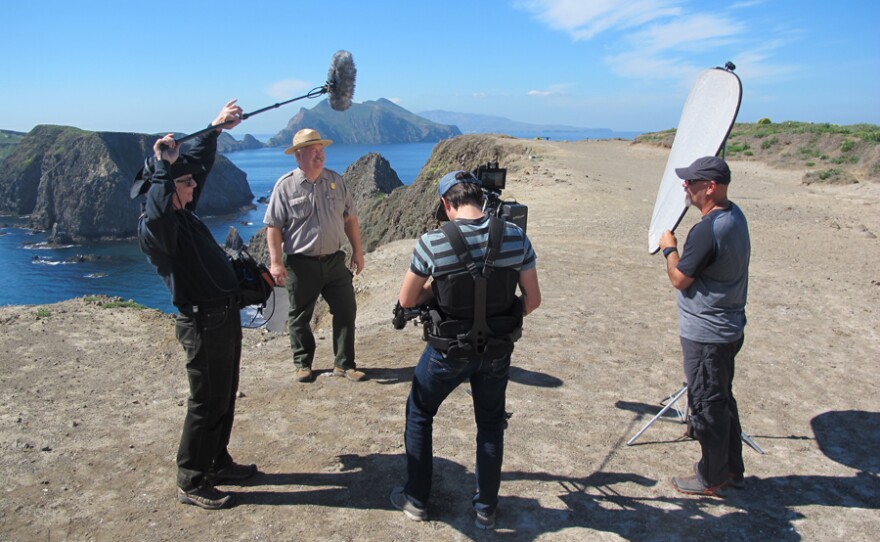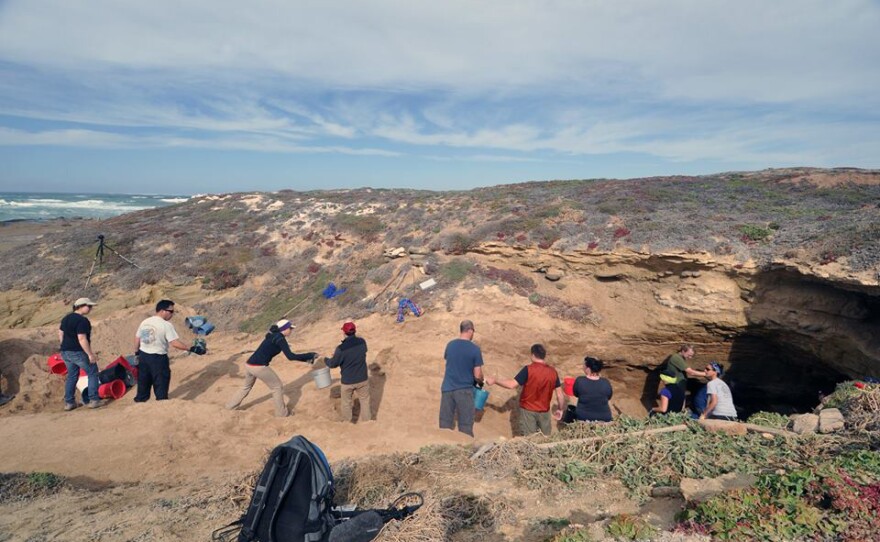WEST OF THE WEST: TALES FROM CALIFORNIA’S CHANNEL ISLANDS is a three-part documentary mini-series on the human history of the eight California Channel Islands. The series is presented by the Santa Cruz Island Foundation and the Santa Barbara Maritime Museum.
The films are engaging and enlightening “tales” told from the point of view of the people who have experienced the Channel Islands – lived on, wrecked on, dived under, filmed, raised children, bootlegged, fished, surfed, sailed, explored and restored in a remarkable saga that begins 13,000 years ago.
WEST OF THE WEST is on Facebook.
EPISODE GUIDE:
Episode 1: “First People" repeats Wednesday, Oct. 19 at 10 p.m. - In the first tale, “Island Rotation,” Tanya Atwater, geophysicist and marine geologist, explains her theory of how once upon a time the Channel Islands used to be located next to San Diego. Over the millennia plate tectonics ‘rotated’ them to where they are now off Santa Barbara.

The San Salvador Replica
View timelapse video of San Salvador construction. Courtesy of the San Diego Maritime Museum

“First Contact – The Voyage of Cabrillo” is actually two parallel stories. One is the voyage of Juan Rodriguez Cabrillo – a Portuguese conquistador sailing for the Spanish – who was looking for China but instead ‘discovered’ Alta California and the Channel Islands. And that was 89 years before the pilgrims got to Plymouth Rock, meaning that America really started here. His story is intercut with the San Diego Maritime Museum’s ambitious, years in the making, and ultimately successful effort to build a replica of Cabrillo’s flagship the San Salvador.
“Sayipak’a (Once Upon a Time)” follows Julie Tumamait, a Chumash tribal leader, as she describes her own reawakening to her Channel Islands native roots. She visits an archeological dig on Santa Cruz Island where she and UCSB archeologist Lynn Gamble discuss the role of archeology and anthropology in helping rediscover Chumash culture which was destroyed after the Spanish mission period in the early1800s.
”Lone Woman of San Nicolas Island” tells the story of the person known variously as Juana Maria, the Lone Woman, or Karana in the children’s classic “Island of the Blue Dolphins,” is familiar to many people. While comparing her incredible real life adventure of surviving alone on San Nicolas for 18 years to the story in the book, we uncover new facts about her life as well as that of the book’s writer Scott Odell.
Episode 2: “Settlers” repeats Wednesday, Oct. 26 at 10 p.m. - First, in “Last Roundup,” Tim Vail, fourth generation rancher on Santa Rosa Island, gives a personal history of his family’s involvement there while lamenting the end of their cattle operation after a century. The parallel story is the birth of Channel Islands National Park as told by Bill Ehorn, the founding Park Supervisor and friend of the Vails.
The Channel Islands lie in one of the most hazardous shipping channels in the world. “Graveyard of Ships” tells the story of the crash of the paddle wheel steamer Winfield Scott into middle Anacapa Island in 1853, Bob Schwemmer of NOAA and others also describe some of the more than 500 other wrecks in Marine Sanctuary Waters. Many of which can be dived on today in this “underwater museum.”
Catalina is the most widely known of the Channel Islands, and the only one still privately owned. Its fame is the result of the vision of one man, William Wrigley Jr. who bought the island sight unseen in 1919. In "Magic Isle – Santa Catalina," we chronicle its glory years of movie stars, the Chicago Cubs, and Big Band dancing in the Casino, as well as its struggles to stay relevant today. William Wrigley’s great grand-daughter Alison Rusack and her family tell us about the challenges and joys of keeping his dream alive.
Then in “The Legendary King of San Miguel Island,” Betsy Lester Roberti travels back to the windswept and desolate island where she grew up as a child. She describes her ‘Swiss Family Lester’ upbringing and her larger than life father Herbie. And his untimely demise on the eve of World War 2.
Episode 3: “Return” repeats Wednesday, Nov. 2 at 10 p.m. - In “Island Restoration,” Novelist TC Boyle talks about his attraction to the Channel Islands that led him to write two books about them. One, “When the Killing is Done,” focuses on the showdown between environmentalists and Channel Islands National Park and Nature Conservancy naturalists who wanted to restore the islands to their native state. This is the spine of our tale and leads to discussion of ‘who gets to play god’ out there, what steps have been taken with various species like the island fox and the bald eagle, and what the results have been.
A monster wave was discovered off San Miguel Island, and “Shark Park” chronicles an expedition of the world’s best big wave surfers led by Greg Huglin to challenge it. Made more dangerous by its location in an area known for its great white shark population.
After a 20-year quest to find a cave reputed to have been used by the Lone Woman, archeologist Steve Schwartz finally discovers the cave. Only to have his excavation efforts shut down by the Navy. “The Cave and the Cache” chronicles the turf war over the cave between archeologists, the Navy and various Indian tribes. It also tells the story of an amazing discovery of the Lone Woman’s ‘cache’ by Jon Erlandson and René Vellanoweth. And shows the over 200 artifacts they preserved.
“The Doctor and the Rock Star” is the story of an odd couple – Dr. Carey Stanton, who owned Santa Cruz Island, and rock star Joe Walsh. Meeting in the 1970s through Marla Daily, they struck up an unusual, and unusually strong, bond that led to Joe putting on an Eagle’s concert to help raise the money for the Nature Conservancy’s purchase of Santa Cruz Island… and ultimately it’s protection forever.
“Dark Water” – The Chumash were a marine culture whose life centered around their plank canoe - the tomol. Since the 1970s when they re-learned how to build the tomol, Chumash paddlers, leaving in the dark of night, have made an annual voyage across dangerous Channel waters to their ancestral home on Santa Cruz Island.
Visit the series website to read more about filmmakers Brent Sumner, Sam Tyler and Peter S. Seaman, and to order a DVD. © 2016 Channel Islands Film, LLC.






